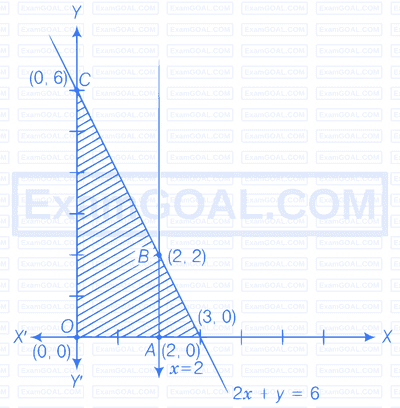Determine the maximum value of $Z=11 x+7 y$ subject to the constraints $2 x+y \leq 6, x \leq 2, x \geq 0, y \geq 0$.
We have, maximise $$Z=11 x+7 y\quad\text{..... (i)}$$
Subject to the constraints
$$\begin{aligned} 2 x+y & \leq 6 \quad\text{.... (ii)}\\ x & \leq 2 \quad\text{.... (iii)}\\ x \geq 0, y & \geq 0 \quad\text{.... (iv)} \end{aligned}$$
We see that, the feasible region as shaded determined by the system of constraints (ii) to (iv) is $O A B C$ and is bounded. So, now we shall use corner point method to determine the maximum value of $Z$.

| Corner points | Corresponding value of Z |
|---|---|
| $(0,0)$ | 0 |
| $(2,0)$ | 22 |
| $(2,2)$ | 36 |
| $(0,6)$ | 42 $\leftarrow$ Maximum |
Hence, the maximum value of Z is 42 at (0, 6).
Maximise $Z=3 x+4 y$, subject to the constraints $x+y \leq 1, x \geq 0, y \geq 0$.
Maximise $Z=3 x+4 y$, Subject to the constraints
$$x+y \leq 1, x \geq 0, y \geq 0$$
The shaded region shown in the figure as $O A B$ is bounded and the coordinates of corner points $O, A$ and $B$ are $(0,0),(1,0)$ and $(0,1)$, respectively.

| Corner points | Corresponding value of Z |
|---|---|
| $(0,0)$ | 0 |
| $(1,0)$ | 3 |
| $(0,1)$ | 4 $\leftarrow$ Maximum |
Hence, the maximum value of Z is 4 at (0, 1).
Maximise the function $Z=11 x+7 y$, subject to the constraints $x \leq 3$, $y \leq 2, x \geq 0$ and $y \geq 0$.
Maximise $Z=11 x+7 y$, subject to the constraints $x \leq 3, y \leq 2, x \geq 0, y \geq 0$.

The shaded region as shown in the figure as $O A B C$ is bounded and the coordinates of corner points are $(0,0),(3,0),(3,2)$ and $(0,2)$, respectively.
| Corner points | Corresponding value of Z |
|---|---|
| $(0,0)$ | 0 |
| $(3,0)$ | 33 |
| $(3,2)$ | 47 $\leftarrow$ Maximum |
| $(0,2)$ | 14 |
Hence, Z is maximum at (3, 2) and its maximum value is 47.
Minimise $Z=13 x-15 y$ subject to the constraints $x+y \leq 7$, $2 x-3 y+6 \geq 0, x \geq 0$ and $y \geq 0$.
Minimise $Z=13 x-15 y$ subject to the constraints $x+y \leq 7,2 x-3 y+6 \geq 0, x \geq 0, y \geq 0$.

Shaded region shown as $O A B C$ is bounded and coordinates of its corner points are $(0,0)$, $(7,0),(3,4)$ and $(0,2)$, respectively.
| Corner points | Corresponding value of Z |
|---|---|
| $(0,0)$ | 0 |
| $(3,0)$ | 33 |
| $(3,2)$ | 47 $\leftarrow$ Maximum |
| $(0,2)$ | 14 |
Hence, the minimum value of Z is $(-30)$ at (0, 2).
Determine the maximum value of $Z=3 x+4 y$, if the feasible region (shaded) for a LPP is shown in following figure.

As clear from the graph, corner points are $O, A, E$ and $D$ with coordinates $(0,0),(52,0)$, $(144,16)$ and $(0,38)$, respectively. Also, given region is bounded.
$$\begin{array}{lrl} \text { Here, } & Z & =3 x+4 y \\ \because & 2 x+y & =104 \text { and } 2 x+4 y=152 \\ \Rightarrow & -3 y & =-48 \\ \Rightarrow & y & =16 \text { and } x=44 \end{array}$$
| Corner points | Corresponding value of Z |
|---|---|
| $(0,0)$ | 0 |
| $(52,0)$ | 156 |
| $(44,16)$ | 196 $\leftarrow$ Maximum |
| $(0,38)$ | 152 |
Hence, $Z$ is at $(44,16)$ is maximum and its maximum value is 196 .